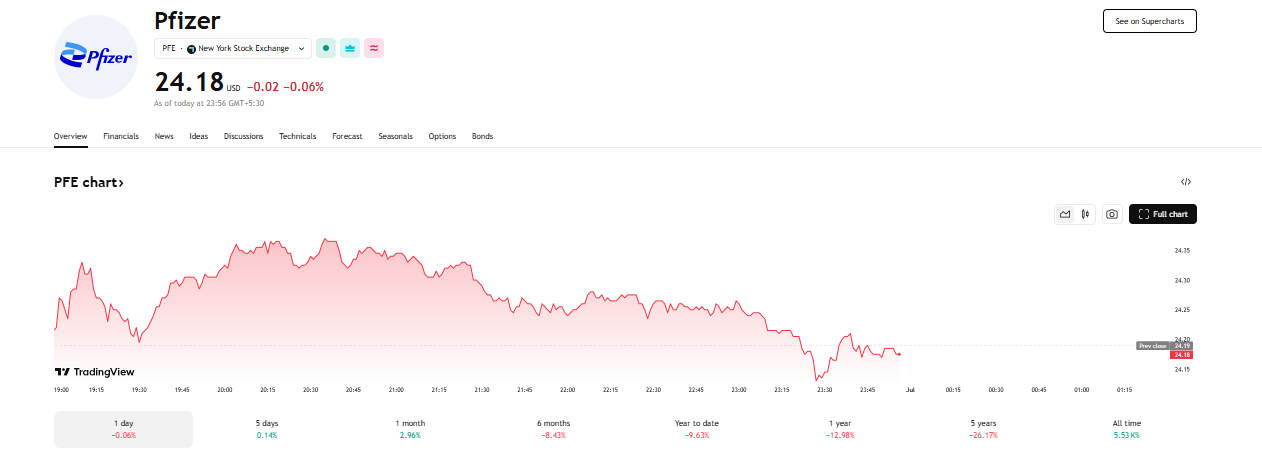Pfizer (PFE) Stock Ends Flat, Highlighting Ongoing Battle to Overcome Post-Pandemic Headwinds

New York, NY – Pfizer Inc. (NYSE: PFE), the global pharmaceutical giant, ended the trading day almost exactly where it started, closing at 0.02, or 0.06%, a performance that encapsulates the company’s current state of stagnation as it navigates a challenging post-pandemic landscape.

While the stock has seen a slight rebound over the past month with a 2.96% gain, the broader picture remains a significant concern for investors. PFE stock is down 9.63% year-to-date and has shed 12.98% of its value over the past year. The five-year performance is even more stark, showing a loss of -26.17%, a period during which the broader stock market saw substantial gains.
This prolonged underperformance stems directly from the dramatic decline in revenue from its blockbuster COVID-19 vaccine (Comirnaty) and antiviral treatment (Paxlovid). The revenue cliff from these products has left a massive hole in Pfizer’s top line that the company is now working diligently to fill.
To combat this, Pfizer has focused on a major strategic pivot, most notably through its multi-billion dollar acquisition of cancer-drug specialist Seagen. This move significantly bolsters Pfizer’s oncology pipeline, an area the company sees as a key future growth driver. However, the market remains skeptical about how quickly new products can offset the loss of COVID-related sales.
For now, many investors are holding the stock for its substantial dividend yield, which has been pushed higher as the stock price has fallen. Today’s flat close suggests a market in waiting, weighing the company’s turnaround efforts against its very real near-term challenges.
Frequently Asked Questions (FAQ) about Pfizer Inc. (PFE)
1. What is the stock ticker for Pfizer?
Pfizer Inc. trades on the New York Stock Exchange (NYSE) under the ticker symbol PFE.
2. How did Pfizer stock perform today?
The stock was essentially flat, closing at $24.18, down just $0.02 or 0.06% for the day.
3. Why has Pfizer’s stock been performing so poorly over the last few years?
The primary reason is the sharp decline in global sales of its COVID-19 vaccine and Paxlovid treatment as the pandemic subsided. This created a massive revenue gap. The stock is also facing pressure from upcoming patent expirations on other key drugs, a phenomenon known as the “patent cliff.”
4. What is the “patent cliff”?
This is a term used when a pharmaceutical company’s key drugs lose patent protection, allowing other companies to produce cheaper generic versions. This leads to a rapid and steep decline in sales for the original branded drug.
5. What is Pfizer’s strategy to return to growth?
Pfizer’s strategy is focused on its drug development pipeline. Its cornerstone move was the major acquisition of Seagen to become a leader in oncology (cancer treatments). It is also focused on launching new products and getting new approvals for existing drugs.
6. Does Pfizer pay a dividend?
Yes, Pfizer is well-known for paying a substantial quarterly dividend. The stock’s declining price has resulted in a very high dividend yield, which is the main attraction for many current income-focused investors.
7. Is the 5-year return of -26.17% a cause for concern?
Yes, for long-term investors, this is a significant underperformance. It means that an investment made in Pfizer five years ago would have lost over a quarter of its value, not including dividends, during a period when the overall stock market grew significantly.
8. Who are Pfizer’s main competitors?
Pfizer competes with other large pharmaceutical companies, including Merck, Johnson & Johnson, AbbVie, Eli Lilly, Bristol Myers Squibb, and Novartis.
9. What are some of Pfizer’s most well-known drugs?
Besides its COVID-19 products, Pfizer’s portfolio includes blockbusters like Eliquis (a blood thinner, co-marketed with Bristol Myers Squibb), Prevnar (a vaccine), Ibrance (a breast cancer drug), and legacy brands like Viagra and Lipitor.
10. What does the recent 1-month gain of 2.96% signify?
This small positive gain suggests some buying interest at the stock’s depressed levels, possibly from investors attracted by the high dividend yield or a belief that the stock has been oversold. However, it’s a short-term trend within a much larger, multi-year downtrend.
11. What was the previous closing price for PFE?
According to the chart data, the previous day’s closing price was $24.19.
12. What is significant about the Seagen acquisition?
The acquisition of Seagen for $43 billion was one of the largest pharma deals in recent years. It gave Pfizer immediate access to Seagen’s approved cancer therapies and its cutting-edge technology in antibody-drug conjugates (ADCs), which are a powerful and targeted way to treat cancer. This is central to Pfizer’s strategy to become a dominant player in oncology.
